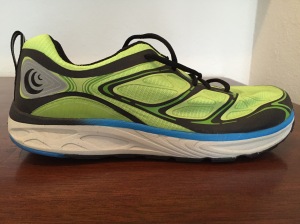I wanted see how various minimalist shoes affect my ground contact time, stride length, vertical oscillation and stride rate.
To do this I used my Garmin 920XT paired with the newest Garmin HRM. You can see the raw data here.
I ran outdoors, approximately 0.3 mile at about a 6 minute pace. I also included a barefoot run at about the same pace, but only made it 0.10 mile, as I am not used to running barefoot on asphalt. I took average readouts for each 0.3 mile loop.
The biggest difference I can see from various shoes is the vertical oscillation. The only outlier is when running barefoot there is a noticeable decrease in GCT and stride length, even at the same pace.
Here is my data:
| GCT (ms) | VO (cm) | Cadence (spm) | Stride Length (m) | |
|---|---|---|---|---|
| Topo Runventure | 219 | 9.9 | 183 | 1.48 |
| Topo Fli-Lyte | 218 | 9.8 | 185 | 1.48 |
| NB 730 | 218 | 9.6 | 186 | 1.46 |
| Vibram Trek Sandal | 220 | 9.3 | 187 | 1.46 |
| Vibram Bikila Evo | 221 | 9.0 | 188 | 1.45 |
| Vibram Trek Ascent | 218 | 9.2 | 186 | 1.45 |
| EarthRunners Alpha X | 220 | 8.9 | 188 | 1.47 |
| xero shoes amuri z-trek | 223 | 8.9 | 186 | 1.44 |
| Barefoot | 212 | 8.4 | 198 | 1.34 |









Interesting data. I always assumed runners spent most of their time in the air. Your data shows you spend about two thirds of the time in contact with the ground. Even though barefoot shows the shortest ground contact time you spend the most time in contact with the ground running barefoot due to the higher cadence. It is not really what I would have expected. I guess my eyes have been tricking me for years.
LikeLike
Where do you get 2/3 time on ground from?
LikeLike
I multiplied your steps per minute by the ground contact time. 0.212 x 198 =41.976 seconds. The most air time you have is with the FliLyte but you are still on the ground for 40.33 seconds with those. I assumed you came in contact with the ground every step.
LikeLike
My mistake. Your runventure gives you the most air time at 40.077 seconds on the ground with 19.923 seconds in the air. I guess the 2/3 time makes more sense when I think about walking with no air time and the ground contact time would exceed 100% using the formula because at times both feet would be in contact with ground. When running I assume only one foot is in contact with the ground at a time.
LikeLike
If you are able to increase your barefoot stride length, it would be the best run. As it is, the barefoot run was one of your slowest (distance over time).
When changing to barefoot, my feet and toes slowly widened closer to a more natural shape. I tried to undestand how the shape of the foot or toes, as deformed by the shape of small toebox shoes, leads to the changed position of the foot and how that affects longer stride. I realized that a thinner width foot along with toes from the outside bent inwards changes the length you are able to extend both the foot and leg angle to touch the ground with. If you understand what I mean, this actually leads to underpronation. Even minimal shoes may not give complete space for the toes in the toebox. But more importantly, they also have a thickness for the sole or a curved, outer, sturdy rubber. And that gives extra distance for the foot to reach with. Which gives the ability to have a longer stride. From your image with your foot shown, I can see that your outside toes curve inward, and that small amount makes a large difference when compounded over the long distance of your lever functioned leg and foot joints. Biking specialists know this when performing a fitting. A few millimeters of change on one part of the leg, can completely change the position and effect it has on the rest of the body.
My toes look similar to yours after months of toe exercise and practice, but to continue further I am going to try the toe spacer and foot pad from naturalfootgear. I had practiced with and exercised my toes and foot to widen, but I have reached a limit. I have realized the toes, as well as the foot bones, need to be held in the correct position for the muscles to be exercised properly, so that eventually the whole foot can adjust to the natural position. I did not want to spend money on these products, but I see this is the only way. I could continue to practice manually widening the foot bones and toes, but that doesn’t hold them in place completely. I tried jumping from a start with this temporarily corrected position, and I was able to achieve greater height and stability because I could use more of my foot. As for the greater stability, I feel like the impact forces can be detected earlier by the outer, first contact toe, and spread out across the increased width of the foot, along with stronger muscles. Falling from a jump seems reversed for the first contact. But it should still apply because the toe positions and foot bones spread still has the same effect.
Therefore because of greater power, in addition to a shorter Ground Contact Time and Vertical Oscillation, distance would also increase.
LikeLike